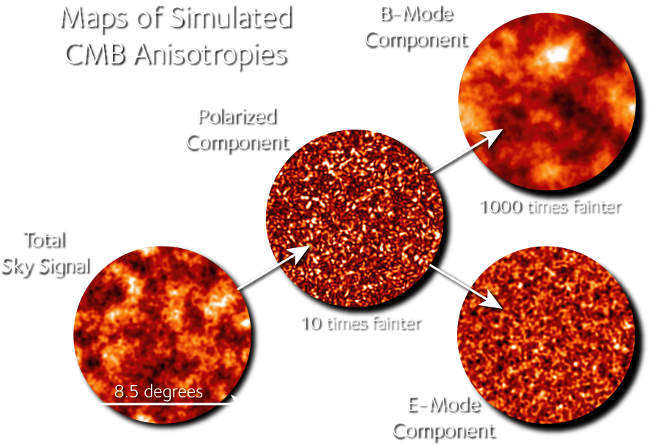Cosmology is the study of the dynamics and evolution of our Universe. I study cosmology because I have a fundamental desire to understand our origin. Humankind has wrestled with cosmological ideas for millennia. However, unlike our ancestors, we live in a time when cosmological observables and theory can be used together to answer some of the most fundamental questions about how our Universe began and how it evolved. These observables are being discovered and precisely characterized thanks to new technologies that allow us to look deeply into the Universe in new ways and image the cosmological landscape clearly for the first time.
One of the most information-rich cosmological observables is the cosmic microwave background radiation (CMB). The CMB is a bath of photons that permeates all of space and carries an image of the Universe as it was 380,000 years after the Big Bang (z = 1100). In general, my research program focuses on developing and using novel enabling technologies to characterize the CMB in variety of ways. Physical processes that operated in the Universe when the CMB formed left an imprint in the CMB signal that can be detected today. This imprint is observed as angular intensity anisotropy, linear polarization anisotropy, and spectral distortions.
The inflationary cosmological paradigm posits that a burst of exponential spacetime expansion, called inflation, took place during the first fraction of a second after the Big Bang. Observational evidence to date is consistent with this paradigm and has given it a strong footing, though inflation has not yet been definitively proven and the precise physical mechanism that caused inflation is unknown. If it happened, inflation should have produced a stochastic background of gravitational waves. These gravitational waves would have produced a distinct curl-like polarization signature, which is commonly called B-mode polarization. The magnitude of this inflationary gravitational wave (IGW) signal is proportional to the energy scale at which inflation occurred. Therefore a measurement of the IGW signal would provide definitive evidence that inflation did in fact occur, and it would place a tight constraint on the theoretical models that describe the inflation mechanism. This discovery would be a breakthrough for both astrophysics and particle physics because there is no way to create inflation-like conditions in a laboratory or particle accelerator.

In addition to the aforementioned IGW signal, B-mode polarization can also be used to probe physics outside the standard cosmological picture. Temperature to B-mode correlations (TB) and E-mode and B-mode correlations (EB) are expected to vanish in the standard model. Therefore, these estimators are sensitive probes for physics outside the standard model. A variety of candidate non-standard-model physical mechanisms that produce cosmological polarization rotation (CPR) already have been identified. Parity violation in the electromagnetic sector via a Chern-Simons coupling can produce TB and EB correlations. A coupling of a pseudo-scalar field to electromagnetism would violate the Einstein Equivalence Principle and would result in TB and EB correlations. TB and EB correlations can also be used to test chiral gravity models and to search for primordial magnetic fields.
Studies of the faint spectral distortions in the CMB are emerging as the next frontier in experimental research. There are three general types of primordial spectral distortions that are predicted by theory: (i) chemical potential mu-type distortions, (ii) Compton y-type distortions, and (iii) a recombination line signal. The mu-type distortions are the result of particles interacting with photons during the very early universe when photons were in equilibrium with matter (z > 50,000). The y-type distortions are produced later (z < 50,000) when Compton scattering becomes an inefficient mechanism for energy exchange; this is the same mechanism that produces the thermal Sunyaev-Zel'dovich effect in galaxy clusters. A recombination line spectrum should have been produced when hydrogen and helium nuclei in the primordial plasma captured electrons during recombination, producing emission lines distinctly different from the usual CMB blackbody spectrum (1000 < z < 10,000). The recombination line signal today should span the GHz to THz range of the electromagnetic spectrum. Although this emission line signal is faint when compared with the CMB blackbody spectrum, the distinct spectral features are, in principle, detectable. A detection of this signal would be a direct confirmation of the recombination history of the Universe because these emission lines must exist if our understanding of the early Universe is correct, and a precise characterization of the spectrum will yield information about the relative abundances of hydrogen and helium in the Universe during recombination because these two nuclei produce unique features in the spectrum.
